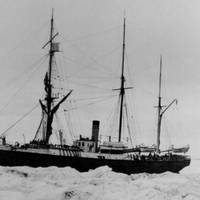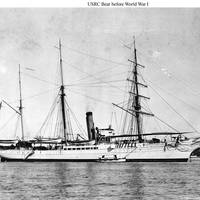Wreck of USRC Bear Found off Nova Scotia

The decades long mystery of a missing U.S. Coast Guard Ship has finally been solved. U.S. Revenue Cutter (USRC) Bear, lost at sea in 1963, has been found on the seafloor about 90 miles south of Cape Sable, Nova Scotia, NOAA Rear Adm. Nancy Hann announced Thursday.Widely considered one of the most historically significant ships in American history, Bear was purchased by the U.S. government and first put into service by the U.S. Navy as part of the rescue fleet for the Greely Expedition to the Arctic in 1884, attaining legendary status for the rescue of the expedition's few survivors.
Enterprise Revisited: Titanium is the USCG Vessel Procurement Magic Bullet

In my May 2020 MREN USS Enterprise column I made a reference to the benefits of titanium as a hull structural material.It related to the life of the USCG cutter Bear and I concluded the column with a suggestion that titanium would be a particularly useful and cost-effective structural material for sail training vessels, aircraft carriers, research vessels, cruise vessels, tugs and Staten Island ferries. I made this suggestion assuming that the hull design (shape) would have to be mature…
Eye on Design: A Titanium USS Enterprise (NCC-1701 that is)

Dennis Bryant provided a link to a story about the USCG Cutter Bear in his March 18, 2020 newsletter. It is a great story about a great ship with a great Captain (Michael Healy) and a great crew. It shows that the right combination of ship and crew can perform miracles.This one ship, its Captain (and his wife who often shipped with him), and its crew did so many things so well that it has become the stuff of legends. I will not further discuss these adventures; some can be found in the article and the rest can be easily Googled.
Navy, Coast Guard Assets Repositioned as Florence Threatens
Preparations underway all along the Eastern Seaboard. As Hurricane Florence threatens a wide swath of the U.S. East Coast, the U.S. Navy and Coast Guard are taking no chances as the dangerous storm advances westward. As that happens, most Navy ships are departing ports in Virginia. As many as 30 vessels from Naval Station Norfolk and Joint Expeditionary Base Little Creek on Monday. Following close behind, the Coast Guard’s medium endurance cutter Bear could also be seen heading for sea.As all Navy installations in the Hampton Roads area were making preparations for the storm’s possible arrival, further south in North Carolina, commercial ports were making similar arrangements.
This Day in U.S. Coast Guard History – December 17
1897-The Overland Expedition, consisting of three officers from the Revenue Cutter Service, departed from the cutter Bear off Nunivak Island to rescue 300 whalers trapped in the ice at Point Barrow, Alaska. The rescuers were First Lieutenant D. H. Jarvis, Second Lieutenant E. P. Bertholf (later a commandant), and Surgeon S. J. Call. The rescuers had to travel over 1,000 miles overland to reach the whalers. 1903-Life-Saving Service personnel from Kill Devil Hills Life-Saving Station helped carry materials to the launch site for the first successful heavier-than-air aircraft flight by the Wright Brothers at Kitty Hawk, North Carolina and then assisted the brothers in their flights that day. The life-savers were John T. Daniels, W.S. Dough and A.D. Etheridge.
This Day in U.S. Coast Guard History – December 16
1897-The Overland Expedition, consisting of three officers from the Revenue Cutter Service, departed from the cutter Bear off Nunivak Island to rescue 300 whalers trapped in the ice at Point Barrow, Alaska. The rescuers were First Lieutenant D. H. Jarvis, Second Lieutenant E. P. Bertholf (later a commandant), and Surgeon S. J. Call. The rescuers had to travel over 1,000 miles overland to reach the whalers. 1903-Life-Saving Service personnel from Kill Devil Hills Life-Saving Station helped carry materials to the launch site for the first successful heavier-than-air aircraft flight by the Wright Brothers at Kitty Hawk, North Carolina and then assisted the brothers in their flights that day. The life-savers were John T. Daniels, W.S. Dough and A.D. Etheridge.
This Day in U.S. Coast Guard History – November 16
1950-A dedication of the monument erected in Arlington National Cemetery on the gravesite of those who lost their lives on the night of 29 January 1945, when USS Serpens was destroyed off Lunga Beach, Guadalcanal. This was the largest single disaster suffered by the Coast Guard in World War II. 1992: The CGC Storis became the cutter with the longest service in the Bering Sea, eclipsing the U.S. Revenue Cutter Bear which had held that distinction since 1929. The Bear was decommissioned in 1929 after serving in the Bering Sea for 44 years and two months. (Source: USCG Historian’s Office)
This Day in Coast Guard History – July 29
1898- The Revenue Cutter Bear took 97 survivors of whaling vessels, who had been caught in Arctic ice and rescued by the Overland Expedition, and transported them to San Francisco. 1948- Congress approved Public Law 810 allowing retirement pay at age 60 for reservists with 20 years of service. Some consider this to be the "birth" of the modern Coast Guard Reserve. 1970- The CGC Vigorous became the first 210-foot cutter to cross the Arctic Circle. This took place while she was part of the 1970 Cadet Cruise Squadron. CDR George Wagner was the commanding officer. 1997- The MLB-44300, the first 44-foot MLB to enter service, suffered an engine casualty in response to a SAR mission conducted for Station Cape Disappointment. She was retired from duty shortly thereafter.
This Day in Coast Guard History – Dec. 17
1897-The Overland Expedition, consisting of three officers from the Revenue Cutter Service, departed from the cutter Bear off Nunivak Island to rescue 300 whalers trapped in the ice at Point Barrow, Alaska. The rescuers were First Lieutenant D. H. Jarvis, Second Lieutenant E. P. Bertholf (later a commandant), and Surgeon S. J. Call. The rescuers had to travel over 1,000 miles overland to reach the whalers. 1903-Life-Saving Service personnel from Kill Devil Hills Life-Saving Station helped carry materials to the launch site for the first successful heavier-than-air aircraft flight by the Wright Brothers at Kitty Hawk, North Carolina and then assisted the brothers in their flights that day. The life-savers were John T. Daniels, W.S. Dough and A.D. Etheridge.
This Day in Coast Guard History – Nov. 17
1950-A dedication of the monument erected in Arlington National Cemetery on the gravesite of those who lost their lives on the night of 29 January 1945, when USS Serpens was destroyed off Lunga Beach, Guadalcanal. This was the largest single disaster suffered by the Coast Guard in World War II. 1992: The CGC Storis became the cutter with the longest service in the Bering Sea, eclipsing the U.S. Revenue Cutter Bear which had held that distinction since 1929. The Bear was decommissioned in 1929 after serving in the Bering Sea for 44 years and two months. (Source: USCG Historian’s Office)
This Day in Coast Guard History – Nov. 16
1950-A dedication of the monument erected in Arlington National Cemetery on the gravesite of those who lost their lives on the night of 29 January 1945, when USS Serpens was destroyed off Lunga Beach, Guadalcanal. This was the largest single disaster suffered by the Coast Guard in World War II. 1992: The CGC Storis became the cutter with the longest service in the Bering Sea, eclipsing the U.S. Revenue Cutter Bear which had held that distinction since 1929. The Bear was decommissioned in 1929 after serving in the Bering Sea for 44 years and two months. (Source: Navy News Service)
Packing Solutions Help Bear Set Sail
In August 2001, the Delamar Company received a call from the Engineering Officer aboard the 270-ft. (82.2-m) USCG Cutter Bear. He described an oil leakage problem from the #1 (starboard) reduction gearbox. The stern outdrive shaft's stuffing box could not maintain a good seal for any length of time, and would allow the leaking gear oil to sling off the rotating shaft onto adjacent clutches. Different types of compression packing had been tried, including graphite-impregnated, but none proved successful against the frictional heat and oil pressure. Additionally, the shaft was suspected to be skewed and misaligned in relation to the gearbox. Bear was scheduled to leave port in just a couple of days for duty, and this leakage wasn't acceptable during operation; it had to be fixed immediately.
Cutter to Return from Africa
The Coast Guard Cutter Bear is scheduled to return home August 15 following an historic 90-day deployment to Africa. As part of a Theater Security Cooperation (TSC) mission with the U.S. Navy's Sixth Fleet, the Bear visited eight countries in North Africa and the Gulf of Guinea region, some of which had never hosted a Coast Guard vessel before. While there, the cutter and its 100-person crew worked with and trained the naval and law enforcement forces of these nations to enhance multinational interoperability and to cultivate relationships for possible future training opportunities. These goals are critical elements to the United States growing commitment to help establish regional stability in Africa.
Cutter Bear Returns Home from Law Enforcement Patrol
The Coast Guard Cutter Bear is scheduled to return to ISC Portsmouth today following a 66-day law enforcement patrol in the Caribbean Sea. The highlight of the patrol came when the crew of the Bear detected a vessel on radar December 19 and flew a deployed MH-68 Sting Ray helicopter based out of Jacksonville, Fla., to identify the large fishing vessel. With permission of the flag state coordinated by the Coast Guard's Seventh District Command Center in Miami, a boarding team from the Bear conducted an extensive, 16-hour boarding. Boarding team members discovered the contraband hidden below concrete in the fish hold. With the flag state's authorization…
Cutter Returns to Portsmouth, Va. After Patrol
The Coast Guard Cutter Bear will return to its homeport of Portsmouth after a 62-day patrol in the southern Caribbean. While underway, the crew conducted excercises with the a Coast Guard Helicopter Interdiction Tactical Squadron (HITRON) in Mayport, Fla., where they trained in interdiction tactics. After the training, the crew steamed south to the Caribbean Basin, in an area known for narcotics trafficking. During 25 days of patrol in this area, a newly qualified watchstander on board spotted a small, fast-moving surface contact on the radar. The embarked HITRON helicopter launched and located a 40-ft. go-fast boat laden with narcotics and extra fuel drums. Before use-of-force tactics could be authorized, the go-fast headed back into territorial seas.







